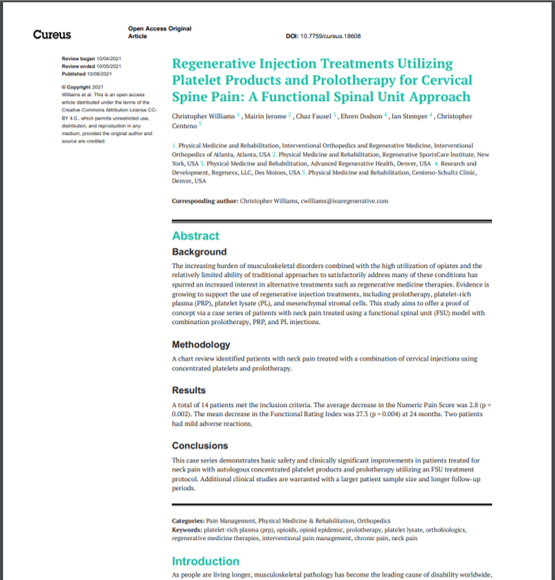Our Newest Published Paper: Spine Functional Spinal Unit

credit: shutterstock
As you may know, Centeno-Schultz and Regenexx have a fellowship program where young doctors are trained and we also have a clinical research team. As a result, we try to publish 2-4 papers a year and this is our most recent. This one is on using a “functional spinal unit” approach to treat back and neck pain. Let’s dig in.
Our Clinical Research Program
Regenexx is one of the few groups in the world that strives to consistently publish lab and clinical research. Why? Because in the field of interventional orthobiologics there is still much to discover and know. In addition. if the field is ever to become standard of care around the world, hundreds of studies need to be published. Hence, Regenexx spends the time, energy, and money to do our part.
How does our research team work? First, we have a fellowship program where young doctors train and are responsible for helping get 2-4 papers out during the year they’re here in training. In addition, the CMO (me) usually picks the research topics for the year. Then we have two lab team members who help spearhead the data analysis and quality control. Finally, we have a clinical research coordinator who is responsible for all of the big picture and rubber meets the road stuff in how we get from an idea to a published paper.
What Is the FSU Approach?
Way back when I took concepts from traditional interventional spine care like fluoroscopy-guided facet injections and epidurals and combined that with the ligament and tendon injections found in traditional prolotherapy and then added some new research on multifidus atrophy and birthed the “Functional Spinal Unit” approach. What’s that? Each spinal level has many parts like:
- Facet joints
- Disc
- Ligaments
- Nerves
- Muscles
- Tendons
So why would you treat just one part and not all of them when all of them are usually going bad all at the same time in a degenerative disc disease (DDD) patient. Hence the FSU approach was born. That approach has now been pretty widely copied by some physicians offering regenerative spine care. They usually adopt parts of it, but few physicians outside of the Regenexx network understand all of it. That’s not a bad thing, as to my mind that has improved what these physicians can offer their back and neck pain patients.
To learn more about this procedure, watch my video below:
Traditional Pain Management and Prolo Have Gaps
Traditional pain management is where a specially trained physician uses precise imaging guidance to inject specific parts of the spine like a facet joint or epidural (around an irritated nerve) or a disc. What’s injected is the first problem, as that’s usually toxic steroids. The second problem is that there is a “pain generator” approach. This is using numbing or provocative injections to try to find the one part of the spine in the list above that’s causing the most pain. While that sometimes can be helpful, it’s often not realistic as in degenerative disc disease all of these parts go bad at the same time.
Traditional prolotherapy has a much more common sense global approach of treating many different ligaments and tendons in larger areas, but it suffers from the fact that these practitioners don’t have the skill set needed to precisely inject things like facet joints and epidural, so these parts of the DDD equation are usually left out.
Hence, the FSU approach takes the best of both worlds, the ability to precisely inject structures and the global injection of ligaments and tendons, and mashes them together and adds in the appropriate orthobiologics rather than toxic steroids or prolotherapy solution. We also call this our “DDD Procedure” or “Perc-FSU” procedure.
Testing the FSU Treatment Hypothesis
There’s a saying in clinical research, “What do we think, what do we know, what can we prove?” For the FSU approach of treating the spine as a whole rather than parting it out, let’s review where we are:
What Do We Think?
This was back when I started using this FSU approach in about 2013/14. The theory was that adding more injection structures would improve outcomes.
What Do We Know?
This is based on clinical observation. I observed more patients getting better with this approach than my old approach which was just injecting a few structures. Hence, I “know” that this works. However, what any one physician observes could be biased, so that means it’s time to get to the next step.
What Can We Prove?
The beginning of this next step is starting the first publication of case reports or case series. That means the results of a number of patients who had this technique. That will eventually morph into controlled trials.
Our First FSU Publication
One of our old fellows, Chris Williams, who is now in Atlanta, became the first physician on earth to present some of our registry data on the FSU approach at the 2018 IOF meeting in Denver. It’s important to note that this was his own self-completed project. Meaning I had little to do with getting this data ready for presentation or even choosing it for Chris as a project, which says quite a bit about the drive that Chris has as a physician innovator.
Ever since then, he and our research team has been getting this data ready for publication. That wasn’t easy, as the FSU approach is variable in that some patients need more levels or structures injected than others. This is really anathema to hardcore research types who perform peer-review for medical journals. So it took a while to get this critical paper published, but thanks to Chris’ dedication, here is that final peer-reviewed paper:
Our New RCT on the FSU
We now need to take the next step by performing a randomized controlled trial with a placebo to prove that this procedure either works or doesn’t. Hence, we are putting the finishing touches on this type of study. That should begin by the first of the new year. Patients will receive free of charge lumbar FSU treatment versus placebo. The patients who get a placebo will eventually get the real treatment, so everyone, in the end, will be made whole. If you have chronic low back pain due to DDD and can’t afford the type of state-of-the-art care we offer, contact our research coordinator Ehren at [email protected].
The upshot? Way back when Regenexx began a revolution in spine care using orthobiologics. That evolved into many different treatment techniques, including the FSU (DDD) procedure. Now we’re again at that stage of taking what we have observed as effective and moving to the next level where we get to put our money where our mouth is and perform a randomized controlled trial. My sincere thanks to Chris Williams who is now a Regenexx provider in Atlanta for having the dedication to see this through to publication, long after his fellowship ended.

If you have questions or comments about this blog post, please email us at [email protected]
NOTE: This blog post provides general information to help the reader better understand regenerative medicine, musculoskeletal health, and related subjects. All content provided in this blog, website, or any linked materials, including text, graphics, images, patient profiles, outcomes, and information, are not intended and should not be considered or used as a substitute for medical advice, diagnosis, or treatment. Please always consult with a professional and certified healthcare provider to discuss if a treatment is right for you.
